MATTERS OF OBSESSION
The rare and expensive: Inside a fine art auction at Strauss & Co
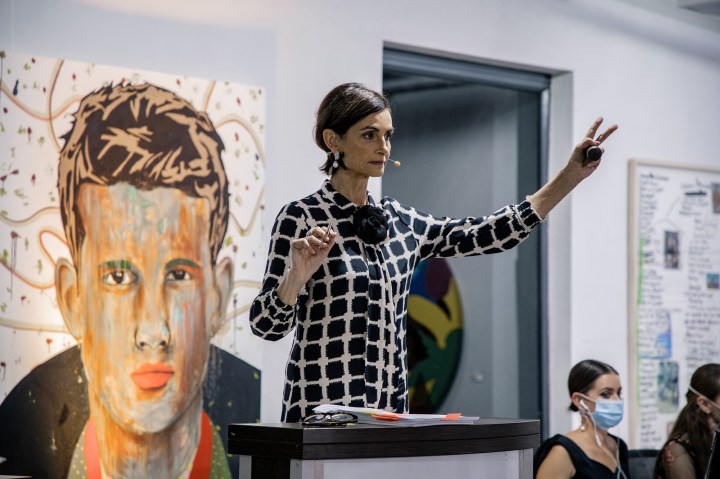
A Jacobus Hendrik Pierneef painting and an Anton van Wouw sculpture fetched R5.1m each. We go behind the scenes at one of South Africa’s fascinating art auctions.
The show starts from the moment you walk into the exhibition space. Held in the impressive structure that is Brickfield Canvas in Woodstock, Cape Town, the Strauss & Co showroom is a marvel of sights: huge windows displaying 360º views of Cape Town’s city, lights, champagne, party dresses, and, of course, the incredible artworks that fill the walls.
Every corner turned reveals a new, spectacular work. Spot a Maggie Laubser to your right; round the corner and come face to face with Irma Stern’s Roses in a Chinese Jar, or a large and arresting Cecil Skotnes; Gerard Sekoto’s The Gossips huddle in the corner. And of course, the prize jewel, hanging next to two of 12 rare Thomas Bowler 17th-century oil paintings, Jacob H Pierneef’s Baobabs, which fetched a massive R5.1-million, the highest bid of the night.
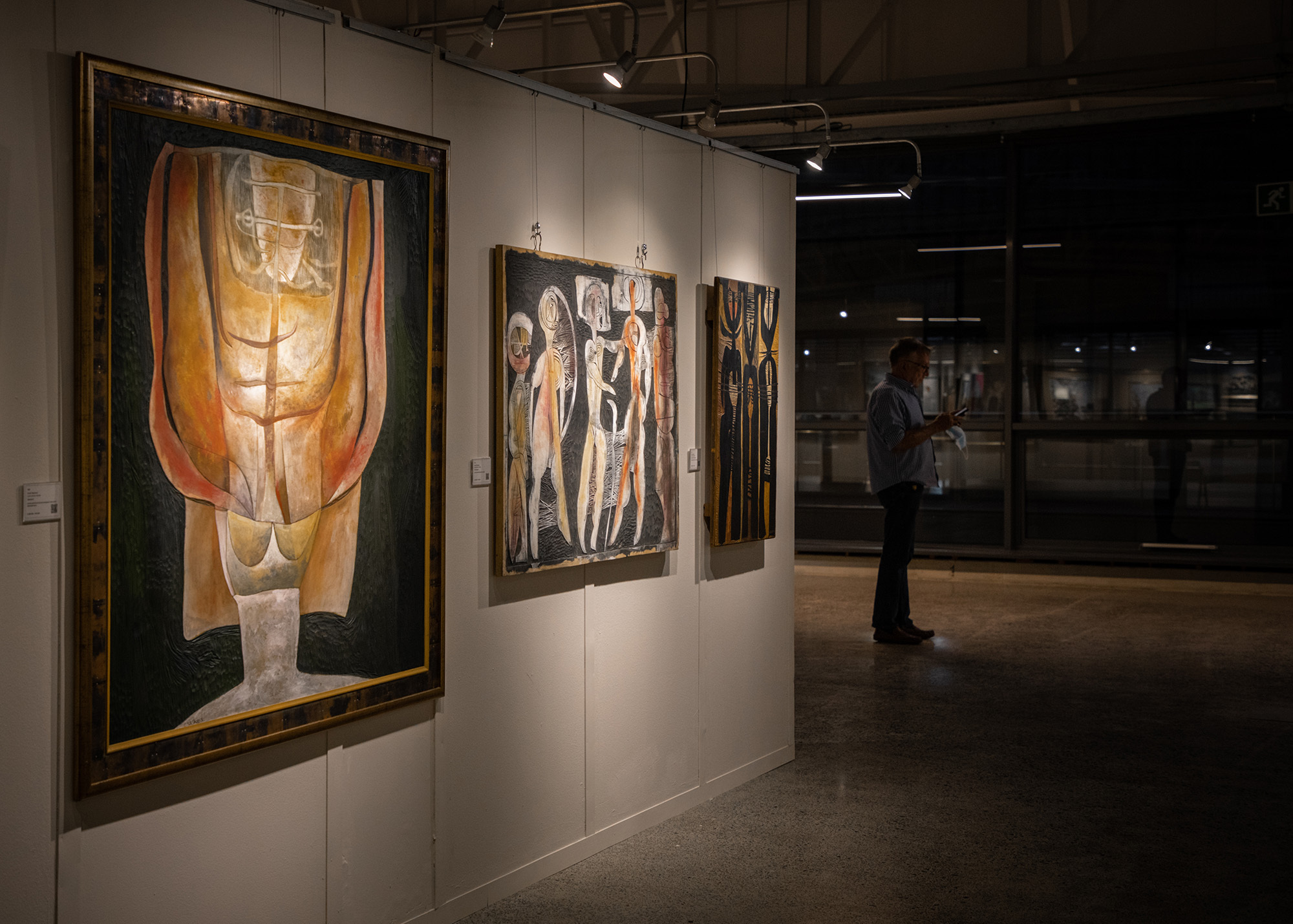
Cecil Skotnes paintings (left to right) “Matriarch”, “Five Figures”, and “Untitled (Three Figures)” on display in Woodstock at Strauss & Co’s live virtual art auction on Tuesday, 13 April 2021. (Photo: Victoria O’Regan)
Yet, the real action is the auction session itself, which takes place at the very back of the room. Rows of metal chairs set up for live bidders are encircled by desks manned by, that night, the Strauss & Co team. Against the wall, team members with old-fashioned landlines sit, tensed, ready for the bids – and the money – to start flowing in.
The room is quieter than could be expected, not the bustling, pushing and shoving aggression that has often been portrayed in Hollywood movies. But the drama is still palpable. If you close your eyes, you can imagine this setting pre-Covid, full of straining, noisy bodies and raised arms.
The 25 or so bidders who have shown up in person sit in the chairs and glance sideways and backward at each other. They hold little papers with their paddle numbers printed on them to their sides in (mock) indifference, ready with a pen to keep track of the sales on the pearly pages of the catalogue given to everyone when they enter the showroom. They are a mixed bunch, most in evening attire – starched white shirts, dress pants, smart black dresses, earrings glinting. Poised, ready; a few, however, are sporting a classic South African look: short-sleeved button-down, shorts, long socks and Veldskoens. The picture of blasé, casually awaiting the moment they might drop thousands of big bucks on a painting.
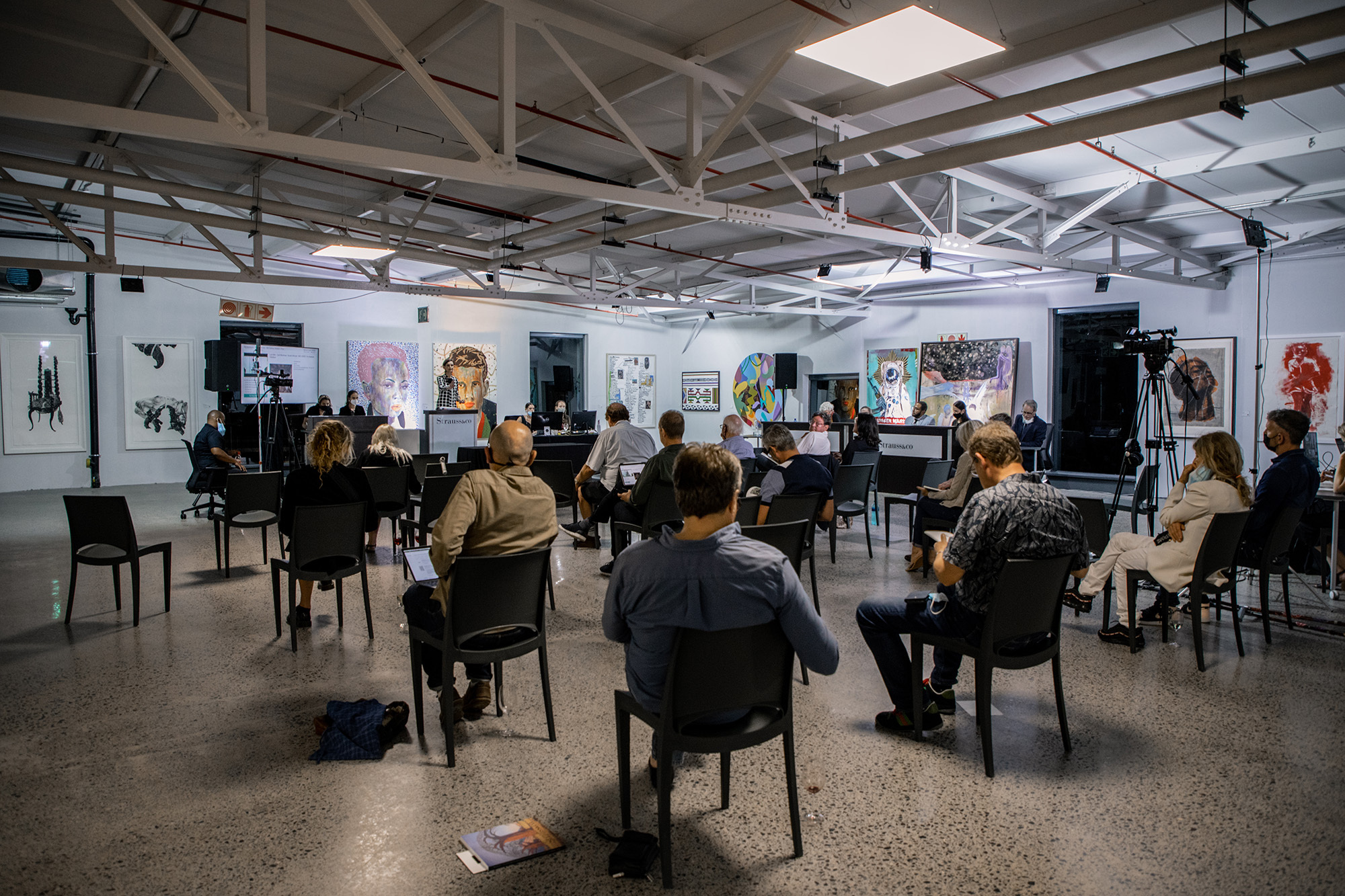
The Strauss & Co’s April live virtual auction at Brickfield Canvas, Woodstock on Tuesday, 13 April 2021. The action concluded last week, with a lot sell-through rate of 81% and a value sell-through rate of 83%, according to Strauss & Co. (Photo: Victoria O’Regan)
Enter Bina Genovese, managing director and auctioneer extraordinaire. She takes her place behind the podium, slender and striking in a floor-length, long-sleeved gown of black and white squares.
The job she must do is not for the faint-hearted. Background-checked bidders can place their bids online, via the telephone, or in person, and it’s the auctioneer’s job, tonight Genovese’s, to keep track of it all. Not only is she an impressive and focused multitasker (with a knack for speaking fast and clearly), she also performs. Gesturing quickly and elegantly towards the bidder holding the highest bid, she looks more like a dancer than someone keeping count. She talks to the online bidders as well as those in the room, giving the impression of addressing a spectral presence that the unknowing audience cannot see. “2.7 million to the man in the back, that’s 2.7 million against you online sir. Can I get 2.8, sir? 2.8 million to the man on the far right.” The clean crack of her hammer on the podium brings a decisive end to the competition. She is in complete control.
“Lot 542,” she announces, “Cecil Skotnes, Stillewe met Bottels, starting at R380 000.”
And so begins the race.
Some of the artworks cause a flurry of activity: two bidders in the room battle each other for Anton van Wouw’s bronze sculpture Slegte Nuus (Bad news), the bid ping-ponging between their pumping arms, and eventually settling at a whopping R5.1-million (sharing the spotlight with the Pierneef.) Some don’t cause any motion at all, and Genovese’s voice, calling for the starting price, echoes alone in the big, white room.
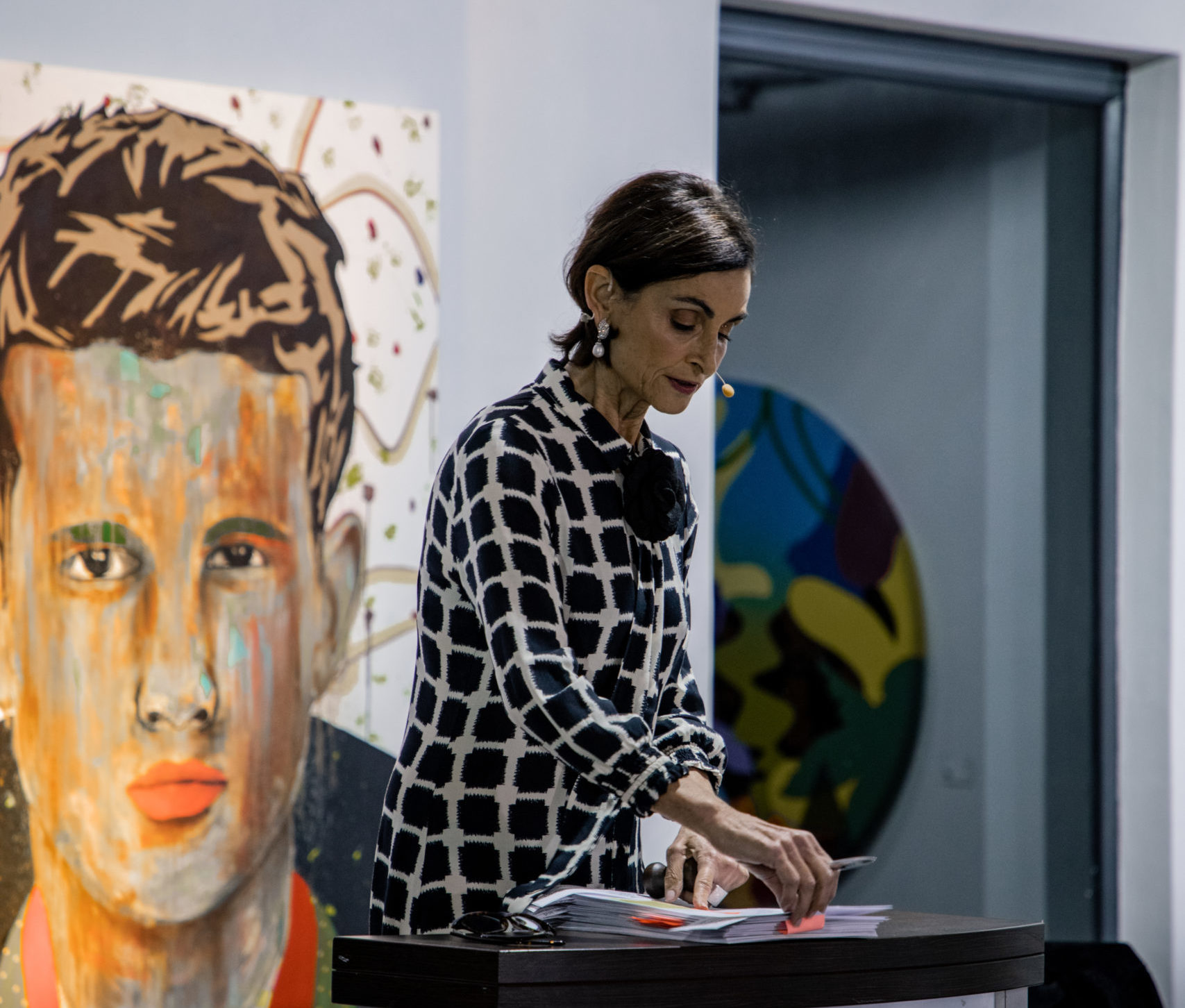
Strauss & Co’s live virtual art auction at Brickfield Canvas, Woodstock on Tuesday, 13 April 2021. (Photo: Victoria O’Regan)
The height of frenzy begins just before Genovese announces lot 564, the Pierneef Baobabs. All five of the telephone operators stand up at once, quietly and quickly muttering into the telephone. Their voices combine into a desperate hum, electricity in the air. It’s felt by the live audience, who straighten in their chairs and glance around the room.
Genovese begins and the numbers go up almost faster than she can pronounce them. One has to sit on your own hands to avoid the dangerous temptation of getting involved in the action.
Quickly, the painting surpasses its estimated value (R2.5–R3-million). When the hammer comes down on the extraordinary final price (R5.1-million), the crowd applauds, and Genovese exhales, having barely taken a breath.
Pierneef, according to the Strauss & Co official press release, is “enjoying a hot streak at auction.” His 1945 painting Elephant Castle, Selati River, Phalaborwa sold for R2.8-million, while his Fishing Boats, Hout Bay, 1942, sold for R2.5-million, landing above and within their estimated value brackets respectively.
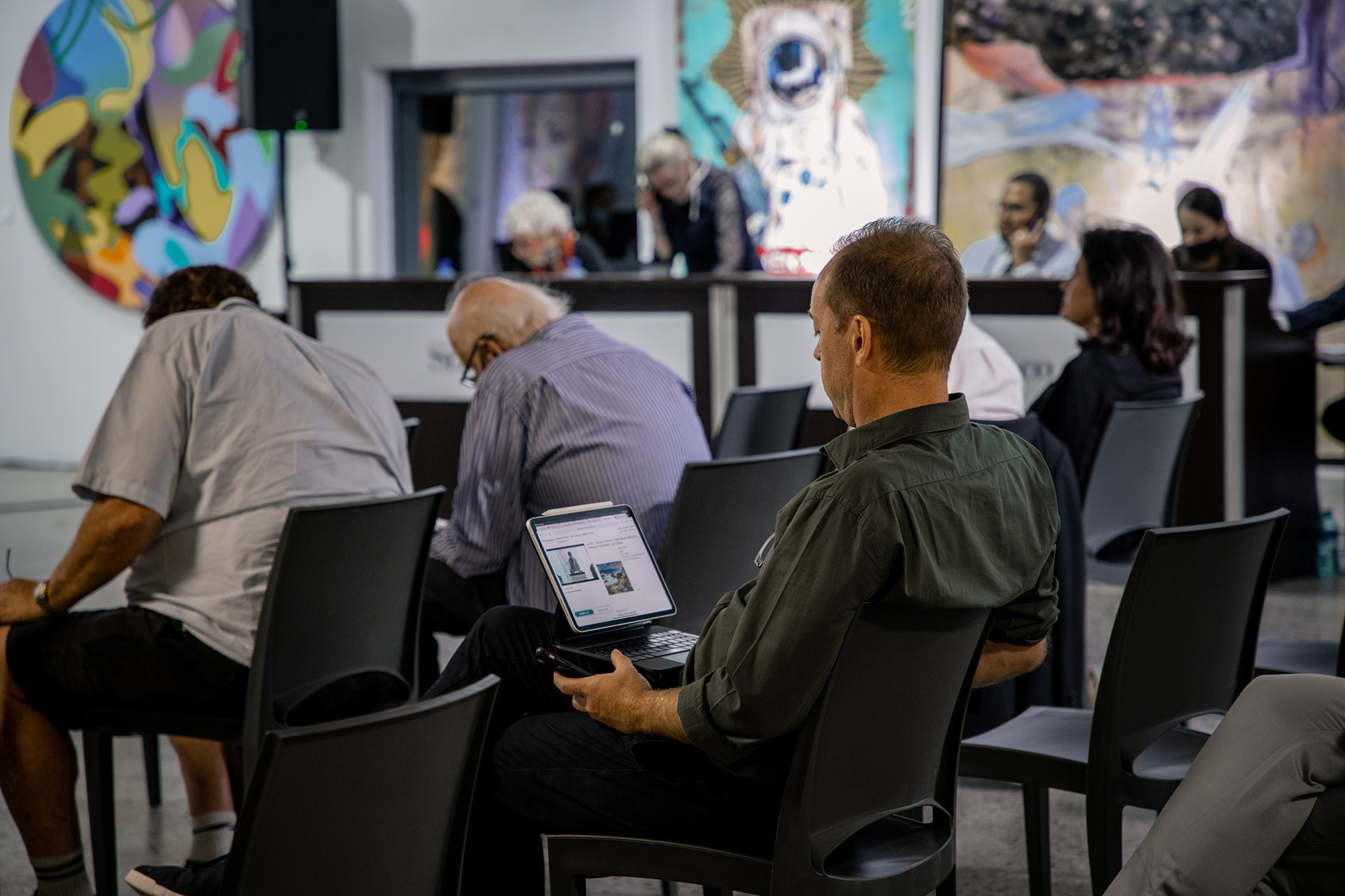
Bidders at Strauss & Co’s live virtual art auction at Brickfield Canvas, Woodstock on Tuesday, 13 April 2021. (Photo: Victoria O’Regan)
Watching, live, as the money spent on a single work rises above and beyond the price of a house, one can’t help but wonder what the deal is with these values. What is it about a surprisingly small rendition of pastel baobabs that would compel a person to spend millions of rand? And why do Pierneef’s Baobab’s go for R5-million, while bigger, older pieces go for almost half of that?
There is a ready market for Pierneef “because he is an artist who formulated a very unique vision of South Africa. He founded a very distinctive and powerful way of depicting the South African landscape,” explains Ian Hunter, a senior art specialist at Strauss & Co.
Jean le Clus-Theron, another senior art expert, explains that the values of paintings by the same artist vary depending “on what the artist’s golden period is, what that artist is known for, which are determined by literature and experts.”
Baobabs, painted in 1952, is an example of an artwork done in a mature stage of Pierneef’s career. At this point, he had mastered his technique and signature style, and the painting displays all of his trademark mastery. According to Hunter, buyers of Pierneef “love a harmonious composition, they like the fusion of the elements. They love the architectonic use of natural elements, like the baobab, with those big trees bridging earth and sky, creating a sense of scale and depth. His colours are so beautifully considered and balanced to create a harmonious whole.”
Listening to Hunter, it’s almost easy to imagine dropping any given amount on a Pierneef. But what of the other artists? Why do the Laubsers or Skotneses (this writer’s personal favourite) sell for so much less?
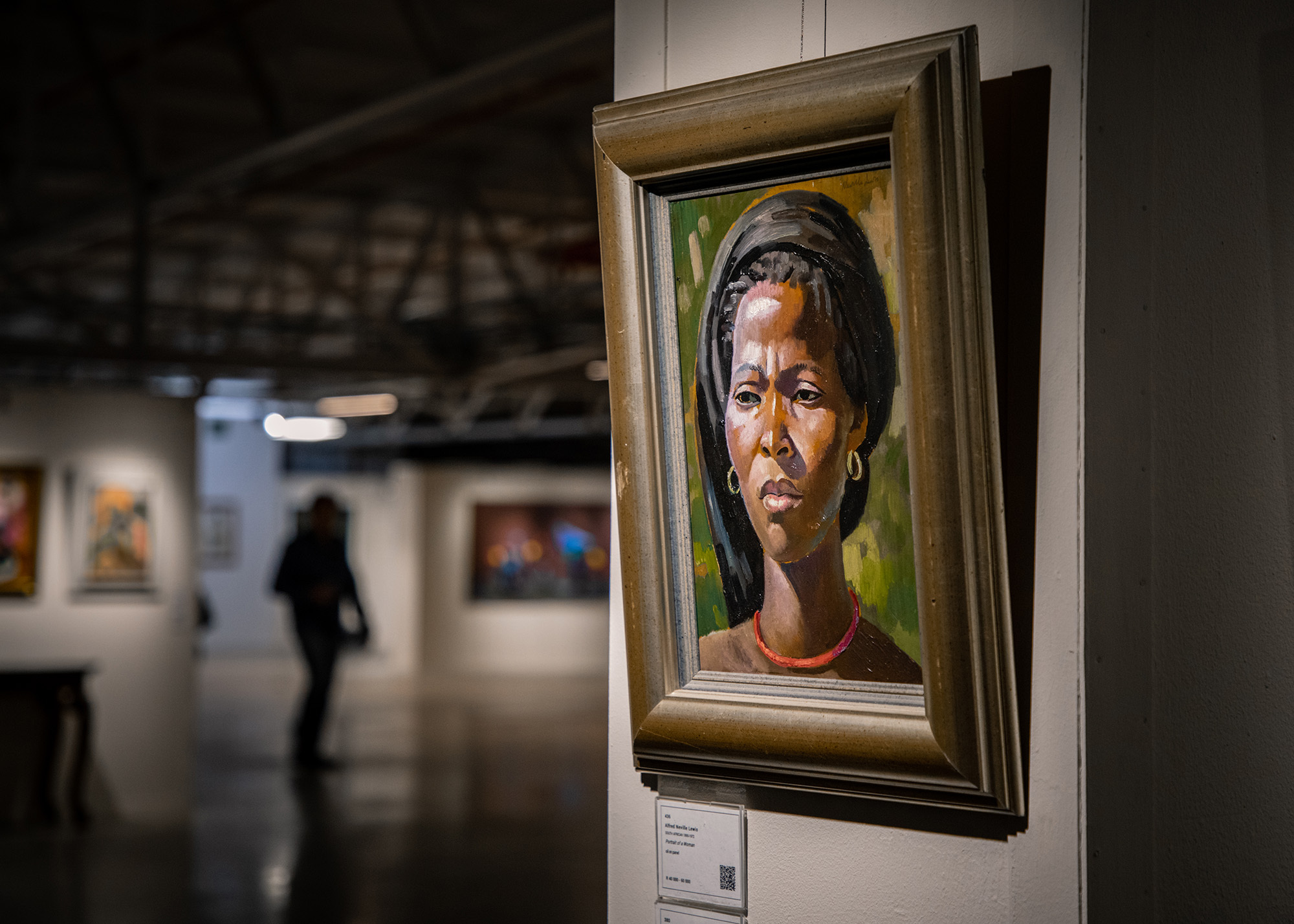
Alfred Neville Lewis’ “Portrait of a Woman” on display at Brickfield Canvas, in Woodstock at Strauss & Co’s live virtual art auction on Tuesday, 13 April 2021. (Photo: Victoria O’Regan)
Hunter explains that it’s all about “critical acclaim, who they have been represented by, in which collections they are held, and in our instance, a long period of production where they have constantly evolved.” It could be skillful self-management, or simply the luck of knowing the right people at the right time, but what is important is that an artist is recognised and celebrated by the insular and highly connected inner circle of the art world. It’s all about knowing the game and playing it too.
Which explains the difference in prices from artist to artist, but not the prices themselves. What possesses people to spend a literal fortune on an artwork?
It’s an age-old, and probably unsolvable mystery (at least to those of us who find such high numbers hard to comprehend at all), but one that has recently been brought up in a new and interesting way.
You may have heard of the rise of the mysterious NFTs (non-fungible tokens) in the world art market.
An article in the New York Times describes NFTs as “assets verified using blockchain technology, in which a network of computers record transactions and give buyers proof of authenticity and ownership.” In simpler terms, an NFT can be any kind of digital file, such as a tweet, meme, or video. For example, Twitter founder Jack Dorsey sold his first-ever tweet as an NFT for $2.5-million. The most confounding thing about NFTs is that in purchasing one, you don’t really own it. Or at least not in the way that we are accustomed to. Anybody with access to the internet could, theoretically, still look at the digital file, or print it out and stick it on the wall. What you are buying, instead, is the undisputable claim of ownership. Every person who looks at Dorsey’s tweet knows exactly who the owner of it is.
Mike Winkelmann (better known as Beeple), sold an NFT called Everydays: The First 5000 Days, at Christie’s for $69.3-million in early March, marking the first ever fully digital work sold at a large fine-art auction. It also achieved the third highest price a living artist has sold work for. Ever.
This is in a very different league to the Strauss & Co sales. In fact, it makes the entirety of the South African art market look like small-fry stuff. But it does bring up interesting questions about value, ownership and authenticity. The value of NFTs rests on the fact that the digital file is permanently linked to the creator and the owner. There is no denying who made or owns it.
Which brings us back to more traditional forms of fine art. A perfect copy of Pierneef’s Baobabs would not sell for as much as a work done by the artist himself, no matter how skillfully rendered.
Part of the work that Strauss & Co and other auction houses around the world do is ensure that everything they sell at auction is high quality and authentic. Many auction houses’ teams include dedicated researchers and cataloguers, and in the case of Strauss & Co, they work closely with Gerard de Kamper, an expert in the authentication of South African artworks.
“Everything on auction is transparent and open to the public,” explains Le Clus-Theron. “We do our due diligence with any piece that we are purchasing, but if there are questions, if we are ever concerned about anything, we would rather steer clear of it.”
In fact, it was Strauss & Co who helped uncover the mystery behind the Pierneef (valued at R8-million) that went missing from the Free State premier’s building when ANC Secretary-General Ace Magashule vacated his office in 2018.
According to Le Clus-Theron, the artworks that are offered at auctions come from a balance of individuals selling single works, perhaps inherited, or gifted, and “single-owner collections”, from those who have collected and curated many works. Baobabs came from a collection titled “property of a gentleman,” curated by a seller who did not want to disclose his identity to the general public.
Le Clus-Theron also mentions that Strauss & Co occasionally go out looking for artworks, taking long road trips in search of masterpieces resting in unusual places. She relates the story of Tretchikoff’s Sunflowers, a piece created in the artist’s “golden age” and found in a tearoom in Durban Road, Pietermaritzburg. The owner, Richard Bunn, bought the painting for 500 guineas and promised not to sell it until Tretchikoff died. The artist passed in 2006, and the work sold to Strauss & Co, who had to clean the grease from its surface to reveal the full effect of the spectacular artwork.
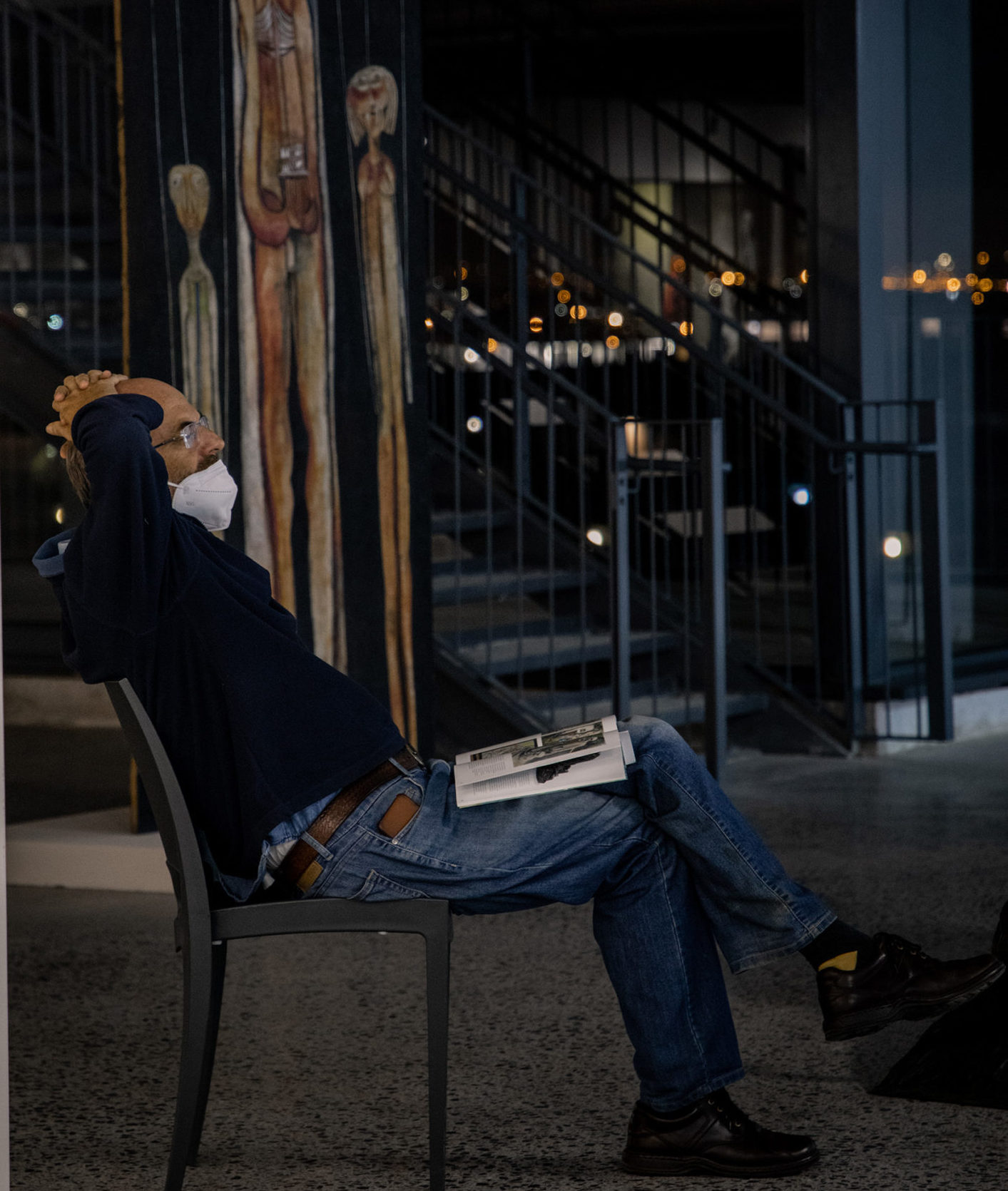
A man attending Strauss & Co’s live virtual art auction in front of Cecil Skotnes’ “Three Figures (Puppets)” at Brickfield Canvas, Woodstock on Tuesday, 13 April 2021. (Photo: Victoria O’Regan)
An auction house often is the centrepiece of the art market. Buyers, sellers, and artists trust auctioneers and consultants to take care of their needs, whether that be smart buying, authenticating works, or selling responsibly.
On Tuesday 13 April 2021, the sale, that, in fact, spanned three days, and included vintage wine sales, decorative arts, and fine art, from the 19th century to contemporary, earned a total of R59.376-million. Across various platforms (telephone, online, and in person) the sale attracted more than 700 bidders from more than 20 countries. DM/ML


















 Become an Insider
Become an Insider
Comments - Please login in order to comment.